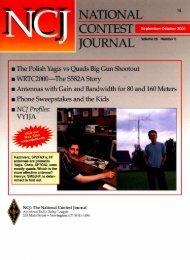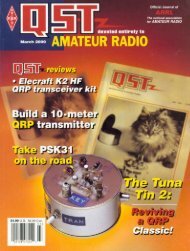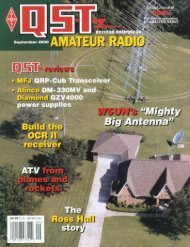News in Brief:• League members now can vote on <strong>QST</strong> Cover Plaque Award: The winner of the <strong>QST</strong>Cover Plaque award—given to the best article in each issue—now is determined by avote of ARRL members. Voting takes place on the ARRL Members Only Web site athttp://www.arrl.org/members-only/qstvote.html. Previously, the award was determinedby a vote of the ARRL Directors. The winner of the February <strong>QST</strong> Cover Plaque Awardwas Dwayne Kincaid, WD8OYG, for his article “A Repeater Controller Accessory: TheRCA.” The March <strong>QST</strong> Cover Plaque Award was the first to be awarded on the basis ofan on-line vote by more than 500 members. The winner was Lew Smith, N7KSB, for hisarticle “A Simple 10-Meter QRP Transmitter.” Congratulations, Dwayne and Lew!• Amateur crowned Miss Topeka <strong>2000</strong>: Heather Hollenbeck,KB0MDX, recently was crowned Miss Topeka <strong>2000</strong> and willcompete in the Miss Kansas <strong>2000</strong> pageant in June. Heathercomes from a ham radio family. Proud mama is MissyHollenbeck, AA0OF, her dad, Fred, is N0WSA, her brother,Jacob, is KB0RMK, and her granddad, Gary Hoffsommer,W0TI, introduced her to Amateur Radio.—Missy Hollenbeck,AA0OF• ARISS crews get initial ham gear training: The firstInternational Space Station expedition crew and its backup crewhave received some initial training on the use of the initial USprovidedAmateur Radio gear to be installed as part of the Amateur Radio on theInternational Space Station, or ARISS, effort. The session was conducted at Russia’sGagarin Cosmonauts Training Centre. As part of the ARISS training effort, NASA’sMatt Bordelon, KC5BTL, was preparing a consolidated schedule for training in the USand in Russia that will include familiarization with equipment, packet theory and handsontraining, using a hardware mockup, and simulation. Training will focus on generalprinciples of ham radio as well as preparations to use ham radio, equipment types andoperating modes, and general packet module information and software. Bordelon hasheld an initial training session with astronauts and cosmonauts that provided exposureto the actual hardware. Other training has included the information required to obtainan US Amateur Radio license. The first ISS crew includes US astronaut Bill Shepherd,KD5GSL, and Russian Cosmonauts Sergei Krikalev, U5MIR, and the recently licensedYuri Gaidzenko.—Carolynn Conley, NASA• ARRL says “thank you” to exemplary Special Service clubs: Every two weeks, aSpecial Service Club will be featured in the ARRL Special Service Club Spotlight athttp://www.arrl.org/field/club/sscspot/. If you’d like to suggest your SSC for the ARRLSpecial Service Club Spotlight, send your information, including e-mail and Web siteaddresses, to Dan Miller, K3UFG, at dmiller@arrl.org. Photographs, particularly thosethat highlight club activities, are especially welcome.• Enhanced DXCC card checking is here: DXCC members may have their cardschecked by local card checkers without having to mail cards to ARRL Headquarters.Under the new program, DXCC card checkers will be able to check all awards except160 meter DXCC, as well as all QSLs from any current DXCC entity. This will apply toboth new awards and endorsements. QSOs made up to 10 years prior to the current yearwill be eligible for field checking, while older cards and those from deleted entitiesstill may be sent to ARRL HQ. Reappointment of DXCC Card Checkers under newcriteria will be necessary. For more information, contact Bill Moore, NC1L,dxcc@arrl.org; 860-594-0234.—DXCC• League announces Club <strong>2000</strong> Achievement Awards: The ARRL Volunteer ResourcesCommittee has established the Club <strong>2000</strong> Achievement Awards to reward the achievementsof ARRL-affiliated clubs. The new incentives program is aimed at recognizinggrowing, thriving clubs that are having a positive public impact through their activities.Throughout <strong>2000</strong>, ARRL Field and Educational Services staff will review the activitiesof participating clubs. The Volunteer Resources Committee will pick four exemplaryclubs—one in each eligible category. Selections will be announced at the ARRLBoard meeting next January. Eligible club categories include clubs with more than 100members; clubs with fewer than 100 members, but more than 25; clubs with 25 orfewer members, and school clubs. Clubs earn points for such activities as ARRL recruitmentnights, regular monthly meetings that are open to the public; instructionalworkshops; ARES and National Traffic System group activities; and special event stations.Clubs with highest point values at midnight December 31, <strong>2000</strong> will be consideredfinalists. A $1000 check from The ARRL Foundation will be awarded to the clubin each category with the highest number of achievement points. Details on how clubscan accumulate points are available on the ARRL Web site at http://www.arrl.org/field/club/club-awards/. For more information, contact Dan Miller, K3UFG,dmiller@arrl.org; 860-594-0340.70 <strong>May</strong> <strong>2000</strong>Plans are being made for an in-personmeeting of coordinators later this year, withinvitations also to be extended to FCC andARRL officials.ARRL SUPPORTS SWITCH TO CISPRSTANDARDSThe ARRL says it supports an FCC proposalto adopt the slightly stricter InternationalSpecial Committee on Radio Interference—orCISPR—standards for conductedemission limits for Part 15 and Part18 devices. In comments filed in an FCCNotice of Proposed Rulemaking (ETDocket 98-80), the League said the proposedFCC standards will reduce both thepotential for interference to Amateur RadioHF operation and manufacturers’ costsfor Part 15 and 18 devices.Last fall, the FCC proposed to amendParts 15 and 18 of its rules to revise the limitsto which unlicensed Part 15 electronicdevices and Part 18 Industrial, Scientific andMedical devices are permitted to conduct RFonto the ac power lines below 30 MHz. Incomments filed January 31, the Leaguecalled conducted RF energy into the powerlines “a particularly significant concern inthe high-frequency range” and called on theFCC to adopt the tighter standards.In general, the current conducted emissionlimit for Part 15 devices between 450kHz and 30 MHz is 250 µV. Part 18 limitsare device-specific. The League pointed outto the FCC that the CISPR standards “areslightly more stringent than the current Part15 and 18 regulations, offering at least a fewdB of additional protection for HF over theexisting Part 15 standard.”ARRL Executive Vice President DavidSumner, K1ZZ, says it’s “no accident” thatthe CISPR standards are as tight as they are.The International Amateur Radio Union is amember of CISPR and has participated activelyin its meetings since the late 1980s,he explained. Sumner credited two hams inparticular—Tom Sprenger, PA3AVV, andChristian Verholt, OZ8CY—who have representedIARU at CISPR meetings—withbeing instrumental in making sure thatCISPR standards take sensitive HF receiversinto account.The ARRL also said it could not acceptany liberalization of broadband emissionlimits that may result from the use of Part18 fluorescent lighting devices or RF lightbulbs. The League said the present limits forsuch devices already are “extremely liberal.”THREE MORE STATES JOIN PRB-1BANDWAGONCalifornia, New York, and Rhode Islandare the latest states to consider enactingPRB-1 legislation.ARRL Southwestern Director FriedHeyn, WA6WZO, said Senate Bill 1714
was introduced February 23 in the CaliforniaSenate. Similar to a PRB-1 measurepassed last year by Virginia’s General Assembly,the California bill would requirelocalities to accommodate Amateur Radioantennas of up to 200 feet, according tolocal population density.Echoing the language of the PRB-1 limitedfederal preemption, the measure saysthat local ordinances regulating antennaplacement, screening or height “shall reasonablyaccommodate amateur radio antennasand shall impose the minimum regulationnecessary to accomplish the legitimatepurpose of the city or county.” The billwould not preclude localities from regulatingamateur antennas with respect to the useof screening, setback and placement, andhealth and safety requirements.Heyn credited Michael Mitchell,W6RW, with helping to get the bill introduced,and he asked California amateursand clubs to contact their state lawmakersto support the measure.On March 7, a bill was introduced in theNew York State Assembly to codify PRB-1into New York State law. Assembly bill A.9947 would require localities to “reasonablyaccommodate” Amateur Radio antennasand would prevent localities from restrictingantenna structures to less than 95feet above ground level or from restrictingthe number of support structures.The bill was sent to the Committee onLocal Governments, which must vote on themeasure before it goes to the full Assembly.Assuming the measure makes it past bothchambers, it would go to Gov GeorgePataki—a former amateur—for his signature.ARRL Hudson Division Director FrankFallon, N2FF, said the bill represents twoyears of work by his Hudson Division PRB-1 Task Force, which spearheaded the bill’sdevelopment as well as a strategy to get itenacted. The Task Force used other successfulstate PRB-1 bills as models and had assistancefrom ARRL Headquarters.A bill, <strong>2000</strong>-S 2304—introduced in lateMarch in Rhode Island’s General Assemblyat the request of Hank Grilk,WA2CCN—also would put PRB-1 into theOcean State’s law books. It would preventlocalities from enacting or attempting to enforcezoning restrictions or prohibitionsagainst the installation or use of towers“and/or antennas” by Amateur Radio licenseesthat would make effective radiocommunication “difficult or impossible.”The Rhode Island bill specifies a minimum50-foot tower height. Grilk, a former ARRLHeadquarters staff member, has solicitedassistance from the ARRL in seeing the billover the legislative hurdles that lie ahead.So far, ten states have PRB-1 laws inplace.ARMED FORCES DAY EVENTAVOIDS HAMVENTION CONFLICTTo avoid a conflict with DaytonHamvention, the Army, Air Force, Navy,Marine Corps, and Coast Guard are cosponsoringthe annual Amateur RadioNOTABLE SILENT KEYS• SKYWARN pioneer Sherman C. Carr, W9NGT, SK: The mancredited with being the father of SKYWARN—Sherman Carr,W9NGT, of Hartford, Wisconsin—died March 15. He was 83and had been ARRL member for nearly 40 years. As WisconsinSection Emergency Coordinator in the late 1960s, Carr establishedthe first Amateur Radio weather-spotting network, theWeather Amateur Radio Network—WARN. He had assistancefrom Dave Theophilus—now W0NRW but then W9KWQ and aNational Weather Service meteorologist in Milwaukee. In thoselargely pre-repeater days, the network operated on 75 meters.Carr’s idea worked so well that other states adopted its basicstructure, which eventually was implemented as SKYWARN. LastJune, the NWS honored Carr for his role by presenting him withits Central Region Special Service Award. Wisconsin’s currentSEC Stan Kaplan, WB9RQR, called Carr “as much a pioneer asthe first astronaut.” Another accolade came from Rusty Kapelaof the National Weather Service in Sullivan, Wisconsin. “Everytime we issue a severe weather warning we are doing so with thehelp of Sherm’s pioneering efforts,” he said. Kapela called Carr“a giant of a man in the Amateur Radio world and in severeweather communications.” Said Wisconsin ARRL Public InformationOfficer Jim Romelfanger, K9ZZ, “Carr leaves a legacyof creativity, incredible dedication and innovation in emergencycommunications, in technical excellence, and thousands of friendswho will remember his chuckle and his grin.”—Jim Romelfanger,K9ZZ• Nevada Section Manager Bob Davis, K7IY, SK: NevadaSection Manager Robert J. “Bob” Davis, K7IY, of Reno diedFebruary 24 after reportedly suffering a heart attack. He was51. Davis had served as Nevada’s SM since July 1997. Prior tothat, he served for two years as an Assistant SM. First licensedin his late teens in Illinois, Davis joined the US Air Force followinghigh school and worked on the radio equipment aboardthe SR-71 Black bird. Following the service, he worked as anIBM service tech, then started up his own remodeling, landscapingand general maintenance business in the Reno area.“Bob has been a valuable asset to the ham radio community,”said Neil Dresbach, WA7KCD, a friend. “He did an outstandingjob as SM.” Dresbach said Davis was always open to variousviewpoints and tried to avoid letting politics get in theway. Survivors include Marina Brenes, KI7DK. ARRL Fieldand Educational Services Manager Rosalie White, WA1STO,has appointed Janet “Jan” Welsh, NK7N, of Henderson to bethe new Nevada SM. Welsh had served as an Assistant SectionManager during Davis’s tenure and formerly served asan ARES Emergency Coordinator. She’ll fill the remainder ofDavis’s term, which ends July 1, 2001.—thanks to DickFlanagan, W6OLD, Neil Dresbach, WA7KCD, and others• Dawn M. Cummings, K1TQY, SK: Women Radio Operatorsof New England President Dawn Cummings, K1TQY, ofKeene, New Hampshire died February 2, as a result of heartfailure. She was 52. A ham since age 15 and an ARRL member,Cummings was an avid traffic handler. She served asmanager of the First Region Net, Cycle 2, of the ARRL NationalTraffic System and as an Official Relay Station.Cummings’ call sign also graced the “Keene Machine”—alocal repeater on 146.805 MHz that she managed. Cummingswas active in SKYWARN and served as an official weatherobserver for the Keene Sentinel and other outlets and participatedin a regional weather net. After her repeater-related rolein the rescue of students stranded on Mt Monadnock,Cummings was cited by New Hampshire Gov Jeanne Shaheenas “an enduring model of volunteerism.” She also was an activeARES member and belonged to the Quarter Century WirelessAssociation. “Dawn was always cheerful and polite, onand off the air,” said Scott Porter, N1SP. “All of us who knewDawn are saddened at the loss. She tirelessly worked for ourhobby, and never sought the limelight.” In addition to her hamradio activities, Cummings was a Red Cross volunteer. Sheowned and operated a consignment craft store in Keene. Herfather, Lem Cummings, K1IOJ, and her mother, Vivian, areamong her survivors. The family invited memorial contributionsto the Keene Machine, in care of Joseph Armstrong,KA1YLN, 21 Clark St, Apt 1, Brattleboro, VT 05901-6437;or The American Red Cross, 83 Court St, Keene, NH 03431.—thanks to Joe Armstrong, KA1YLN, and Scott Porter, N1SP<strong>May</strong> <strong>2000</strong> 71
- Page 6 and 7:
May 2000 Volume 84 Number 5David S
- Page 11 and 12:
THE AMERICAN RADIORELAY LEAGUE INC
- Page 14:
Get to Know Your Section ManagerThe
- Page 18:
The ARRL and the FCC’s Private Wi
- Page 22 and 23: The postman always keys twice.Accor
- Page 26 and 27: CORRESPONDENCEYour opinions count!
- Page 30 and 31: By Ian Poole, G3YWXOperating in the
- Page 32 and 33: By Roger Sullivan, WA0ETE, and Hugh
- Page 34 and 35: By Jim Graver, KB8PSO2000Dayton Ham
- Page 36 and 37: Figure 1A—Schematic of the interf
- Page 38 and 39: All input/output connections are ma
- Page 40 and 41: Figure 4—Hanger loopconstruction.
- Page 42 and 43: Figure 2—A GOES-8 picture capture
- Page 44 and 45: By Steve Ford, WB8IMYPSK31 2000In e
- Page 46 and 47: the software, PSK31 tuning required
- Page 48 and 49: WORKBENCHPROJECTS AND INFORMATION F
- Page 50 and 51: By Martin A. Minow, K6MAMPractice M
- Page 52 and 53: the download to a suitable location
- Page 54 and 55: 52 May 2000SHORT TAKESHeil Sound Go
- Page 56 and 57: By Zack Lau, W1VTA No-Tune 2-Meter
- Page 58 and 59: HINTS & KINKSA FOLD-DOWN MOBILE-ANT
- Page 60 and 61: By James Kates, N9GBBConfessions of
- Page 62 and 63: PRODUCT REVIEWKenwood TM-D700A Dual
- Page 64 and 65: is accomplished by using OK, BACK a
- Page 66 and 67: other radio operation. The chatter
- Page 68 and 69: operation because there’s so litt
- Page 70 and 71: consideration in the WT Docket 98-1
- Page 74 and 75: communications tests in celebration
- Page 76 and 77: I’ve done this tour several years
- Page 78 and 79: The Crystal Symphony at anchor off
- Page 80 and 81: Table 1Claimed North American Dista
- Page 82 and 83: Okay in My LogBy Vic Curtis,WA3YUVP
- Page 84 and 85: their 432 MHz triumph of the previo
- Page 86 and 87: 2000 ARRL Field DayRulesBy Dan Hend
- Page 88 and 89: Collecting Vintage QSLsOLD RADIOAn
- Page 90 and 91: DIGITAL DIMENSIONAPRS Digipeater in
- Page 92 and 93: AT THE FOUNDATIONWhy We Fund Museum
- Page 94 and 95: It is with deep regret that we reco
- Page 96 and 97: COMING CONVENTIONSARRL NATIONAL CON
- Page 98 and 99: checking; handicapped accessible; f
- Page 106: of the West Allis ARC and served as
- Page 110: introduced that could of had a bear
- Page 114: 211/109; NJN/L 29/203/103; CJTN 29/
- Page 118: W1PEX 1048, WA1JVV 143, N1NH 105, W
- Page 124:
an activity we enjoy so much can be
- Page 128:
126He is President of the Amateur R
- Page 132:
is Walt Bacon, N6SMT, who is curren
- Page 150:
Ham Adsl) Advertising must pertain
- Page 154:
BAHAMAS RENTAL: Abaco villa w/stati
- Page 164:
“EVERYTHING FOR THE MORSE ENTHUSI
- Page 168:
TUBES WANTED: Highest prices paid o
















